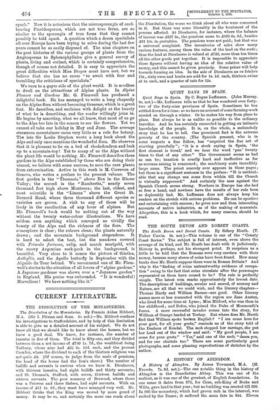CURRENT LITERATURE.
THE DISSOLUTION OF THE MONASTERIES.
The Dissolution of the Monasteries. By Francis Aidan Hibbert, M.A. (Sir I. Pitman and Sons. Cs. net.)—Mr. Hibbert confines his investigations to Staffordshire, and by help of this limitation is able to give us a detailed account of his subject. We do not know all that we should like to know about the houses, but we know a good deal. We know, for instance, the number of inmates in five of them. The total is fifty-one, and they divided between them a net income of .£749 ls. 7d., the wealthiest being Tutbury, whose nine had £22 3s. 10d. each, and the poorest Croxden, where tho dividend to each of the thirteen religious was not quite £9. (Of course, to judge from the scale of pensions, the head of the house had the lion's share.) The number of bailiffs and servants is curious when we know it. Dieulacres, with thirteen inmates, had eight bailiffs and thirty servants ; and St. Thomas's, Stafford, with seven, thirteen bailiffs and sixteen servants. The poor nunnery of Brewood, where there was a Prioress and three Sisters, had eight servants. With an income of £11 1s. 6d., they must have managed very well. Mr. Ilibbert thinks that the King was moved by mere greed of money. It may be so, and certainly the more one reads about the Dissolution, the worse we think about all who were concerned in it. But there was some liberality in the treatment of the persons affected. At Dieulacres, for instance, where the balance of income was £227 5s., the pensions came to £163 Cs. 8d., besides £31 10s. in gratuities. The pensions were not paid; but that was a universal complaint. The inventories of sales show many curious features, among them the value of the lead on the roofs ; thus the lead at Dieulacres is valued at £722, more than ten times all the other goods put together. It is impossible to appreciate these figures without having an idea of the relative value of money, and this cannot be given precisely. Some prices will help towards forming an idea. In the sale of Dieulacres an ox fetches 15s., sixty ewes and lambs are sold for is. ld. each, thirteen swine at is. each, and a quarter of oats for 12s.


























































 Previous page
Previous page